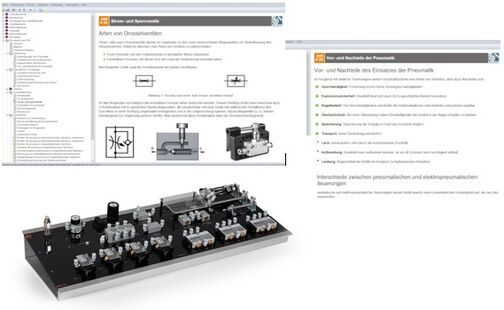UniTrain Course: Pneumatics

The course imparts the basic knowledge of pneumatics. In all practice-related project tasks, core and specialist qualifications are imparted in an integrated manner, including independent planning, execution and control.
Basic training in a wide range of vocational fields is intended to impart skills and qualifications in a practice-oriented manner. In order to carry out a qualified professional activity, the pupils should in particular learn how to plan, carry out and control independently as well as how to act in the overall context of the company.
Learning content:
Occupation-specific specialist qualifications, e.g. the manufacture, assembly and disassembly of assemblies and systems, should be taught integrated with core qualifications, e.g. the planning and organisation of work and the evaluation of work results. Business processes and quality assurance systems in the area of application are, among other things, learning contents of the occupation-specific technical qualification.
In detail:
- Understanding physical laws of pneumatics such as pressure difference and compressibility.
- get to know and take into account the legal requirements and safety regulations
- learn and use the most important symbols of pneumatics
- understand the function of basic pneumatic circuits
- recognize the typical behavior of pneumatic components in different operating situations
- Determine characteristic values
- Creating circuit diagrams with the circuit diagram software
- open virtual instruments from the course software
Pneumatic components:
ExperimentalBoard with:
- 1 x pressure gauge 0 to 10 bar
- 1 x 3/2 shut-off valve, mechanically operated
- 1 x pressure control valve
- 1 x pressure sensor
- 1 x pneumatic distributor, 6-fold
- 1 x 3/2-way valve, push-button, not actuated open (NO)
- 3 x 3/2-way valve, push-button, not actuated closed (NC)
- 1 x shuttle valve, OR
- 1 x double pressure valve, AND
- 2 x Double-acting cylinder, d = 10 mm, h = 80 mm with travel stop
- 1 x single-acting cylinder, d = 10 mm, h = 25 mm
- 2 x 3/2-way valve, sensing roller
- 1 x 5/2-way valve, with spring return, pneumatically operated
- 2 x 5/2-way valve, impulse, pneumatically actuated
- 2 x Proximity switch, pneumatic, with holder
- 2 x throttle check valve
- 2 x potentiometer
- 1 x quick exhaust valve
- 2 x non-return valve, pilot operated
- 1 x Quick coupling
- 10 x sealing plugs
- 5 x T-distributor
- 1m hose 6mm
- 5m hose 4mm
Learning contents:
- path-step diagram
- path-time diagram
- Direct control of single-acting cylinders, extending
- Direct control of single-acting cylinders, retracting
- Direct control of double-acting cylinders
- Indirect control of double-acting cylinders
- Speed regulation of double-acting cylinders
- Speed regulation of double-acting cylinders with quick exhaust valve
- Control of double-acting cylinders with impulse valve
- Travel-dependent control of double-acting cylinders
- Logic control with two pressure valves 1
- Logic control with two pressure valves 2
- Logic control with alternating and dual pressure valves 1
- Logic control with alternating and dual pressure valves 2
- Sequence control of two double-acting cylinders
- Stop control through pilot-operated check valves
- Manual operation of cylinders with speed regulation
- Control of double-acting cylinders with proximity switches
- Endless switching with stop switch